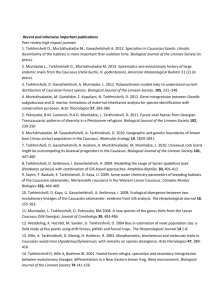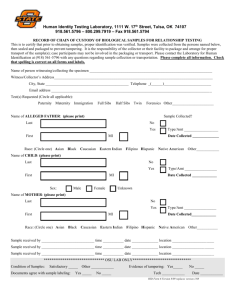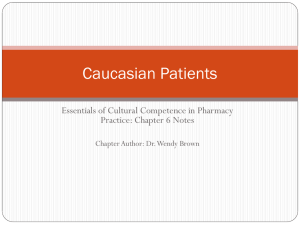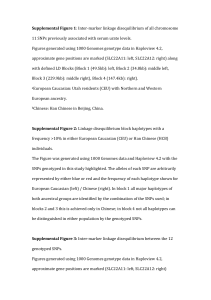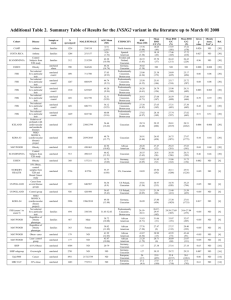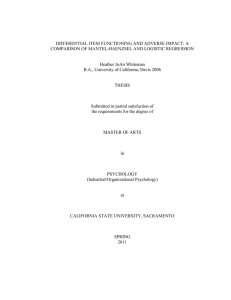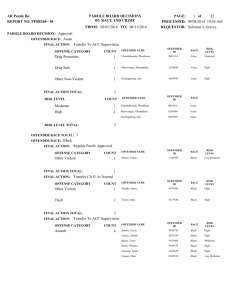Daniel abstractCaucasian
advertisement
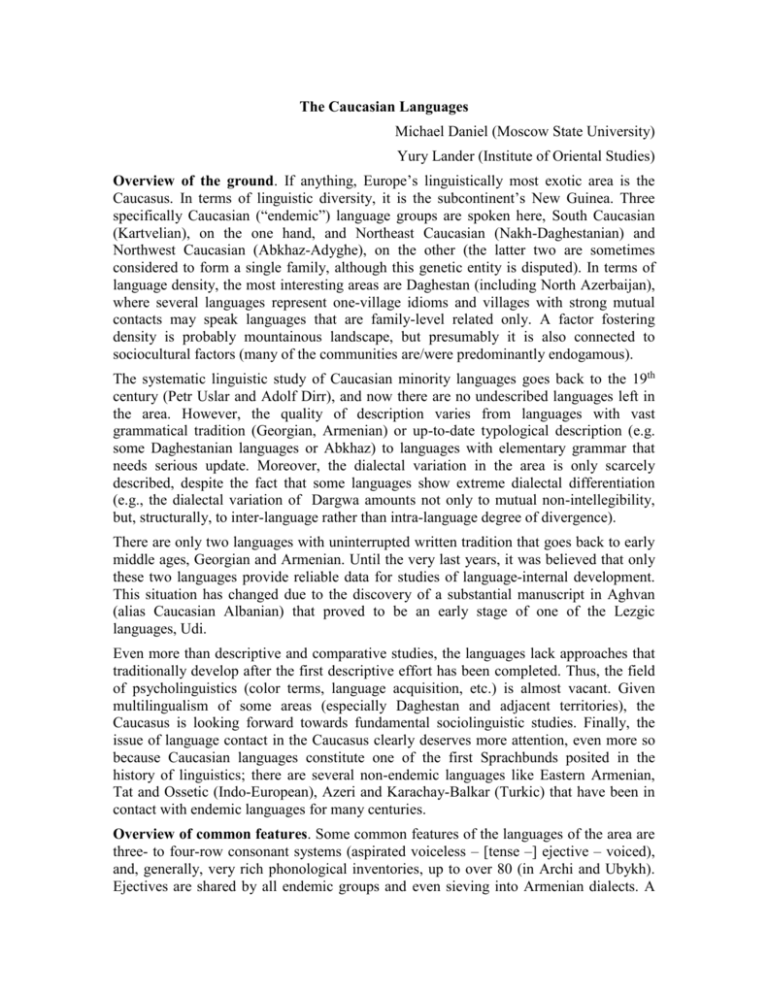
The Caucasian Languages Michael Daniel (Moscow State University) Yury Lander (Institute of Oriental Studies) Overview of the ground. If anything, Europe’s linguistically most exotic area is the Caucasus. In terms of linguistic diversity, it is the subcontinent’s New Guinea. Three specifically Caucasian (“endemic”) language groups are spoken here, South Caucasian (Kartvelian), on the one hand, and Northeast Caucasian (Nakh-Daghestanian) and Northwest Caucasian (Abkhaz-Adyghe), on the other (the latter two are sometimes considered to form a single family, although this genetic entity is disputed). In terms of language density, the most interesting areas are Daghestan (including North Azerbaijan), where several languages represent one-village idioms and villages with strong mutual contacts may speak languages that are family-level related only. A factor fostering density is probably mountainous landscape, but presumably it is also connected to sociocultural factors (many of the communities are/were predominantly endogamous). The systematic linguistic study of Caucasian minority languages goes back to the 19th century (Petr Uslar and Adolf Dirr), and now there are no undescribed languages left in the area. However, the quality of description varies from languages with vast grammatical tradition (Georgian, Armenian) or up-to-date typological description (e.g. some Daghestanian languages or Abkhaz) to languages with elementary grammar that needs serious update. Moreover, the dialectal variation in the area is only scarcely described, despite the fact that some languages show extreme dialectal differentiation (e.g., the dialectal variation of Dargwa amounts not only to mutual non-intellegibility, but, structurally, to inter-language rather than intra-language degree of divergence). There are only two languages with uninterrupted written tradition that goes back to early middle ages, Georgian and Armenian. Until the very last years, it was believed that only these two languages provide reliable data for studies of language-internal development. This situation has changed due to the discovery of a substantial manuscript in Aghvan (alias Caucasian Albanian) that proved to be an early stage of one of the Lezgic languages, Udi. Even more than descriptive and comparative studies, the languages lack approaches that traditionally develop after the first descriptive effort has been completed. Thus, the field of psycholinguistics (color terms, language acquisition, etc.) is almost vacant. Given multilingualism of some areas (especially Daghestan and adjacent territories), the Caucasus is looking forward towards fundamental sociolinguistic studies. Finally, the issue of language contact in the Caucasus clearly deserves more attention, even more so because Caucasian languages constitute one of the first Sprachbunds posited in the history of linguistics; there are several non-endemic languages like Eastern Armenian, Tat and Ossetic (Indo-European), Azeri and Karachay-Balkar (Turkic) that have been in contact with endemic languages for many centuries. Overview of common features. Some common features of the languages of the area are three- to four-row consonant systems (aspirated voiceless – [tense –] ejective – voiced), and, generally, very rich phonological inventories, up to over 80 (in Archi and Ubykh). Ejectives are shared by all endemic groups and even sieving into Armenian dialects. A further typologically rare feature is pharyngalization, found in some Northeast Caucasian and Northwest Caucasian languages. In grammar, we should first of all mention spatial expressions. South and Northwest Caucasian as well as some Lezgic languages feature locative preverbs. Most Northeast Caucasian languages use a very peculiar system for coding spatial relations on nouns by double-suffixing two classes of markers, localization and, optionally, direction. Many Nakh-Daghestanian languages also possess special vertical deixis demonstratives. Most languages possess at least tripartite deixis system: this is also true of Armenian who kept tripartite system lost in many Indo-European languages. The families show variation in their case paradigms, ranging from Abkhaz which has no cases to Circassian languages mainly distinguishing direct and oblique to classical-type systems of Kartvelian and Armenian to extremely rich declension in North-East Caucasian. Most endemic languages of the area are consistently ergative in both case marking and agreement. The latter is present, again, in each of the three groups, though having very different status – polysynthetic-type cross-referencing of several arguments in Northwest Caucasian vs. polypersonal person-number agreement in South Caucasian vs. class-number agreement in Northeast Caucasian. Other fascinating typological topics include peculiar focus constructions, heavy use of converbs for subordination (and, arguably, clause-chaining), and many other features. Important typological “absences” include, from birdsview on the area, only peripheral use of vowel length, and strict two-number systems with no additional numbers (paucal or dual), no inclusive pronouns except in Daghestanian,. Focusing on genetic groups. Some further characteristic features of the three endemic groups are given below. Northeast Caucasian: oblique markers in nominal declension carried by all cases except direct, sematically motivated agreement classes, often, a closed class of simple verb stems in combination with heavy use of light verbs, the absence of valence-changing morphology except causatives. Northwest Caucasian: poor vowel systems (down to monovocalic interpretations), verbal polysynthesis, heavy use of applicatives. South Caucasian: polypersonal verbal agreement, complex valence-changing morphology, sophisticated strategies of argument case marking depending on morphosemantic class of the verb and its TAM categories. Selected bibliography Alekseev, M. E. 1985. Voprosy sravnitel’no-istoriceskoj grammatiki lezginskix jazykov. Moscow: Nauka. Alekseev, M.E. 1988. Sravnitel’no-istoricheskaja morfologija avaro-andijskix yazykov. Moscow: Nauka Boeder, W. 1979. Ergative syntax and morphology in language change: the South Caucasian languages. In F. Plank (ed.), Ergativity. N.Y.: Academic Press. Bokarev, E.A. 1961 Vvedenie v sravnitel'no-istoriceskoe izuchenie dagestanskix jazykov. Moscow. Colarusso, J. 1988. The Northwest Caucasian Languages: A Phonological Survey. Garland Publishing, New York. Comrie, B. (ed.) 2005. Introduction to Caucasian. Lingua 115. Dumezil, G. 1933. Introduction à la Grammaire Comparée des Langues Caucasiennes du Nord. Paris: Champion. Harris, A.C. 1985. Diachronic Syntax: the Kartvelian Case. N.Y.: Academic Press. Hewitt, G. 2004. Introduction to the Study of the Languages of the Caucasus. Muenchen: Lincom Europa. Kibrik, Aleksandr E. & Sandro V. Kodzasov. 1988. Sopostavitel’noe izuchenie dagestanskix jazykov:Glagol. Moskva: MGU. Kibrik, Aleksandr E. & Sandro V. Kodzasov. 1990. Sopostavitel’noe izuchenie dagestanskix jazykov: Imja. Fonetika. Moskva: MGU. Klimov, G.A. 1986. Vvedenie v kavkazskoe jazykoznanie. Moscow: Nauka. Kumakhov, M.A. 1989 Sravnitel’no-istoricheskaja grammatika adygskix (cherkesskix) jazykov. Moscow: Nauka. [Plus monographs by the same author on comparative phonology and morphology.] Kumakhov, M. & K. Vamling 2006. Ergativnost’ v cherkesskix jazykax. Malmö University. Nikolaev S. L. and S. A. Starostin. 1994. A North Caucasian Etymological Dictionary. Moscow. Schulze, W. 1998. Person, Klasse, Kongruenz: Fragmente einer Kategorialtypologie des einfachen Satzes in den ostkaukasischen Sprachen. Band 1: Die Grundlagen. München: Lincom Europa. Smeets, R. (ed.) 1989-1994. The indigenous languages of the Caucasus. 4 vols. Delmar, NY: Caravan Books. Trubetzkoy, N.S. 1931. Die Konsonantsysteme der ostkaukasischen Sprachen. Caucasica 8: 1-32. Vinogradov, V.V. (ed.) 1967. Jazyki narodov SSSR IV: Iberijsko-kavkazskie jazyki. Moscow.


